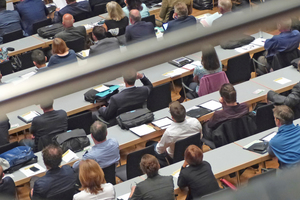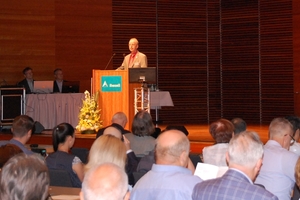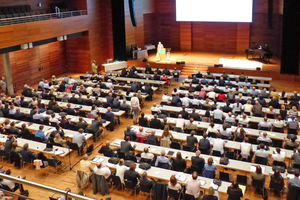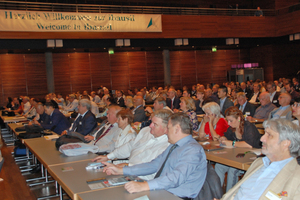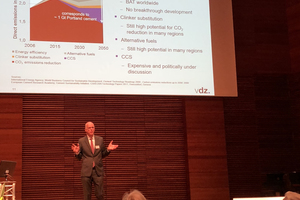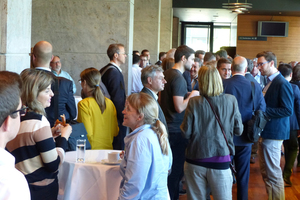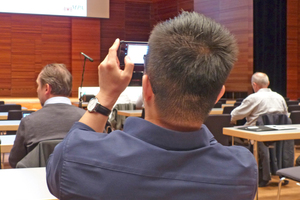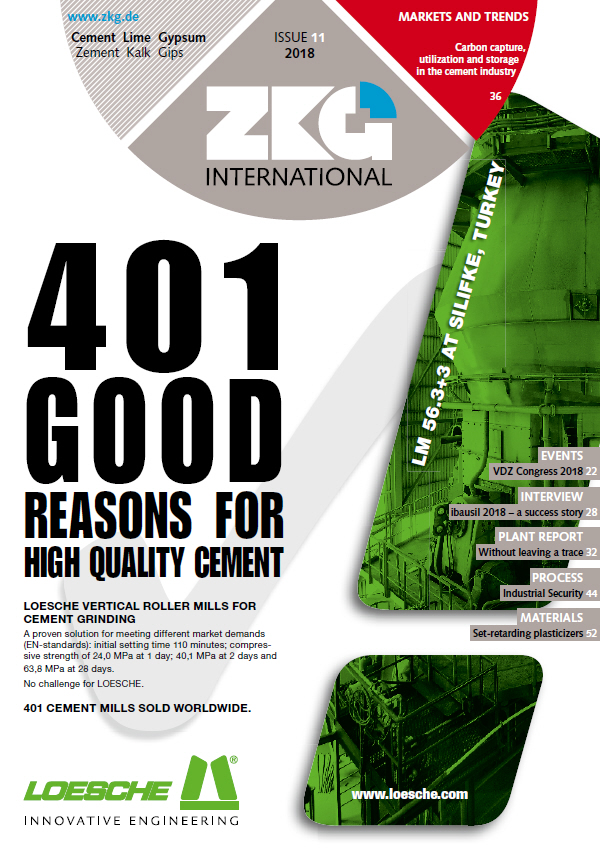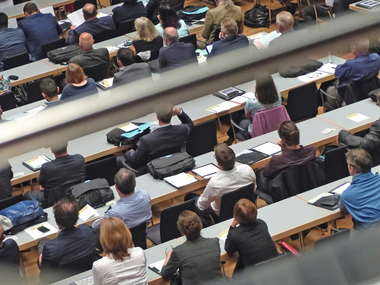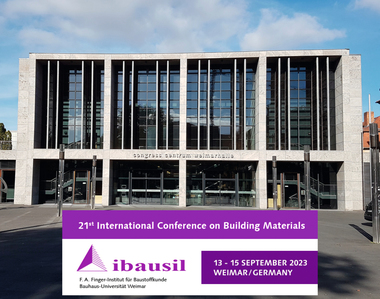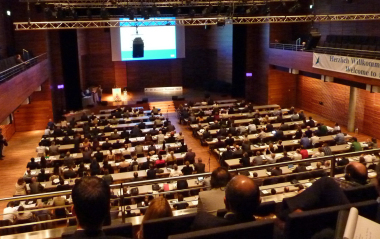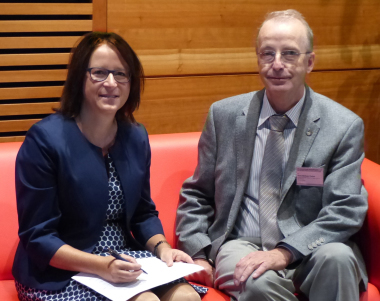Building bridges between academia and industry as well as east and west
Some 650 attendees from 26 different countries gathered in Weimar for the latest ibausil – International Conference on Building Materials. Now, for the 20th time around, the event was hosted in the tried-and-tested fashion by the F. A. Finger Institute for Building Material Science (FIB) at the Bauhaus-Universität Weimar and Bauhaus Academy of Professional Development.
1 More than 50 years of knowledge sharing in the building materials branch
In his welcome address to this year’s anniversary conference, Horst-Michael Ludwig, Director of the F.A. Finger Institute for Building Materials Science, stressed the huge importance of this scientific event. Since 1964, ibausil has been a conference at which “bridges are built, with east and west and academia and industry coming together”. Ludwig sees good prospects for the future of this conference with its high-calibre attendees: “States have broken up, the world has changed, but ibausil will continue“. While ibausil started in 1964 with 417 attendees, in the 1980s between 700 to over 900 interested attendees were welcomed to Weimar. Following German reunification, with just 252 attendees, the event experienced a breakdown in 1991. In the course of the following years, the number of attendees increased again, with recent events averaging around 650 representatives from science and industry.
Ludwig expressed special thanks to the long-serving conference secretary Hans-Bertram Fischer for his dedication.
As always, ibausil was devoted to the current issues in the branch. These included one of the currently most important issues in the industry – reducing CO2 in cement production. For the first time, an entire session was devoted to 3D technology – ibausil keeps up with the times. In this context, Ludwig recalled with a smile the long-standing principle of not making any 3D concretes, which, however, meant at the time: three doctors should not be needed to be able to make concrete. Today, 3D manufacturing signals the start of a new era of manufacturing, enabling completely new design and architectural solutions. Key conference topics were cementitious binder with 56 presentations, durability of concrete with 28 presentations, high-performance/special concretes with 26 presentations but also walling materials, recycling, construction chemicals, analytics and gypsum were also included on the programme. From the 250 papers submitted, 224 lectures were selected, which were held and discussed parallel in up to five halls.
Minister President of the Free State of Thuringia, Bodo Ramelow, emphasized how at the beginning it had not been remotely imaginable that east and west would meet together. Ramelow: “It is not banal that ibausil has already been in existence for such a long time.” Weimar was with its long building and architecture tradition was, he continued, a good place to get talking to each other about modern building. Ramelow, who sees digitalization as a great challenge, called on the industry to “Create modern building materials for us!”
In his paper “The 20th ibausil – a look back”, Jochen Stark recalled the beginnings of the conference and selected prominent participants. From the total of four conference secretaries, Hans-Bertram Fischer had been doing this job for around 30 years. “During the same time, Italy has had 20 governments,” said Stark, praising his dedication with a twinkle in his eye.
In his paper headed “Build with less for more”, Werner Sobek presented lightweight construction with its minimal materials as a necessity for the whole of society. A steadily growing global population not only consumed enormous volumes of building materials, it also caused more and more traffic jams and increasing emissions. New solutions were necessary to counter this development. Sobek spoke, for example, about gradient concrete, with which, for the same dimensions and load-bearing capacity, around 50 % less weight was necessary.
2 Additive manufacturing, sulphate attack and steelmaking slag
The first three plenary lectures addressed significant topics in the industry.
Christoph Gehlen presented “Additive manufacturing of concrete elements through selective cement paste intrusion”. The big advantage of additive manufacturing is that no special tools are required for manufacturing. The process technology comprises extrusion, 3D-printing or selective binding. Another great benefit is that a high complexity of the shapes manufactured is possible. In tests with pastes with a w/c value of 0.3, with the additive manufacturing method of selective cement paste intrusion with high filling degrees, strengths of up to 78 MPa could be reached after 7 d.
In his paper “Sulphate attack on concrete – mechanism, testing and damage prevention”, R. Douglas Hooten reported on many forms of external sulphate attack on concrete. He explained the common test methods in the USA and Canada and reported on the positive effects of SCM for blended cement. The etringite and thaumasite forms of chemical sulphate attack can be minimized by making good quality concrete with low w/c in combination with a restriction of the C3A content of Portland cement.
Horst-Michael Ludwig informed attendees about “Potential uses for steelmaking slag in the building materials industry”. In jointly conducted tests between the FIB of the Bauhaus University of Weimar and Loesche GmbH, solutions for a high-grade use of LD slags as a reactive cement substitute or concrete additive were developed, Now it is a matter of introducing these test results into practice, In further tests, the electric furnace slag is to be modified. Particular attention will be given to a vitrification of the material.
3 The entire spectrum of building materials
From Wednesday to Friday afternoon, the researchers and field professionals presented their test findings in up to five halls. Most of the topics were grouped into blocks to give the attendees a compact overview. The much-discussed topics included composite cements, the use of calcined clay, cement hydration, gypsum, recycling and special concretes, 3D printing, calcium aluminate cements as well as many more. Cement chemistry made up a large part of the lecture topics. With the extensive range of fascinating papers held in parallel, it was very difficult to choose which lecture to attend. All attendees, however, received two volumes of conference proceedings including most of the presentations. A poster session rounded off the presentation of scientific findings.
Here we are only able to provide a brief insight into some of the most important topics.
3.1 Cement
For Martin Schneider, who spoke on “Innovation and technical trends in cement production”, CO2 abatement is the most important topic for the cement industry. Here energy efficiency plays a significant role and alternative fuels have great future potential. Schneider also said: “Carbon capture is possible but expensive.” Influencing the clinker factor also offers great potential for further optimization with regard to environmentally friendly cement production.
For Albrecht Wolter, too, the clinker factor is an important factor. Clinker substitution rates of around 25 % are state of the art. Higher substitutions rates will be pushed by climate change and cost reduction potential. Other significant information from the paper were: EN 197-1 is under way accordingly and the most attractive substitutes are GBFS and fly ash, calcined clay will not gain a share as main constituent in cement. The void-filling degree by solids and the inner particle size distribution“ (iPSD) are new parameters for the optimization of multi-constituent cements. Methods for iPSD control have been established for laboratories and quality management in the works.
Gern Bolte reported on the “Production optimization of composite cements with low environmental footprint”. In this project, the type and quantity of the hydrate phases and the resulting porosity were calculated by means of thermodynamic modelling with consideration of the interactions between clinker, foundry sand and limestone. The objective of the studies was to reduce the clinker content and accordingly improve cement performance. The modelling predictions were verified with laboratory tests. The optimized cements show, despite a lower clinker factor, a compressive strength that is comparable with that of commercial cements. Combinations of foundry sand and limestone can therefore contribute to a further reduction in clinker content.
3.2 Calcined clay
Several papers addressed the topic of calcined clay.
Karen Scrivener presented, for example, findings on “Developments in limestone calcined clay cements”. Calcined clays are available in large quantities. More than 50 clays worldwide were tested and projects conducted, for example, in Cuba and India. Future cements will be based on Portland cement clinker with increasing levels of SCM incorporation. For Scrivener, calcined clays are the only realistic option for extending the use of SCMs. Calcined clays have a very positive impact on chloride ingress and ASR. It is possible to obtain similar mechanical properties to OPC/CEM I with 50 % clinker and clays with > 40 % kaolinite.
For Karl-Christian Thienel, too, calcined clays are an important raw material for the future. He reported on the “Performance of calcined clays in mineral construction materials”. A calcined natural clay mix with a low kaolinite content verified its suitability as SCM in full-scale tests. This and another variety calcined at 1 000 °C performed well under hydrothermal conditions and can serve as a lime substitute in calcium silicate masonry units. Both varieties can replace completely calcium-sulphate-based materials and in addition parts of the cement in autoclaved aerated concrete.
André Trümmer established in his paper “Production of frost-resistant concretes with the use of calcined clays as the main cement component” that very reactive calcined clays can be used for frost-resistant systems.
3.3 3D printing
The topic of 3D printing was represented for the first time with its own session and several papers.
“Particle bed 3D printing techniques for concrete construction – Possibilities and challenges” was the topic addressed by Dirk Lowke. He established: Particle-bed 3D printing techniques are applicable in concrete construction, for direct component production as well as for formwork production. Main advantages are a high resolution and almost no restriction in freedom of form. But basic research regarding the control of the intrusion process, material properties for selective binder/cement activation technique and reinforcement integration are necessary.
Hans-W. Krauss informed about “Concrete additive manufacturing – challenges and solutions by the SC3DP”, a new process developed in Braunschweig. This “Shotcrete 3D printing (SC3DP) offers many opportunities, like automation and digitalization of the manufacturing, increased precision and efficiency as well as fast manufacturing on a large scale. With this genuine 3D printing (in all directions) that can be combined with numerous manufacturing systems, reinforcements, consoles etc. can be integrated. The system exhibits a good bond and good mechanical properties. In the material development, reproducibility, automation, process control, surface quality, etc., there is still need for development.
Niklas Nolte also saw in his paper “Layer composite in additive manufacturing – Influencing factors and process comparison” great potential for the shotcrete method. With higher roughness, better interlocking and therefore very good mechanical properties can be achieved. In the tests, it was established that computer tomography was a very good instrument for material structure analysis.
3.4 Foamed gypsums
On the topic of gypsum there were separate sessions in which the topics of hemi-hydrate, calcium sulphate composite binders etc. were addressed.
Foamed gypsums were one topic. Saskia Nowak and Heike Dreuse reported on the “The practical application of foamed gypsums” and “Calcium sulphate binders for foamed building materials for use as insulation material or filling masonry”. In future, foamed gypsums will be available for horizontal insulation layers with fire protection properties or as material-compatible filler for masonry containing calcium sulphate. A foamed building material was developed on the basis of a ready-mixed dry mortar and an aged moulding plaster, which can be used for horizontal applications and as masonry filling. Here pumpable application over a distance of up to 45 m and a height of up to 15 m is possible without problems. Besides a significant improvement in sound insulation, a fire resistance class F120 could be proved. One of the biggest successes is that foamed gypsums have an extremely low water requirement and low drying requirement in the case of flowing and pumpable application.
4 Outlook
Naturally, scientists and field professionals used the time to discuss research findings and establish new connections. The next ibausil will take place in 2021.
//www.ibausil.de" target="_blank" >www.ibausil.de:www.ibausil.de

